|
Rare Protein Mutation Offers New Hope for Heart Disease Employee Evaluation Process Undergoes Change
Rare Protein Mutation Offers New Hope for Heart DiseaseBy Dan Krotz Berkeley Lab researchers have discovered the mechanism by which an extremely rare protein mutation shields people from cardiovascular disease. The discovery could lead to more potent drug therapies that both target cholesterol deposition and prevent future accumulation. The mutation enables the protein to curb oxidation, a harmful process in which molecules with unpaired electrons, also called free radicals, scavenge electrons from healthy tissue. It's believed to play a role in such diverse diseases as Alzheimer's, osteoporosis, and a form of heart disease known as atherosclerosis. In the latter disease, free radicals grab electrons from lipids that line artery walls, sparking an inflammatory response that paves the way for cholesterol deposition. The mutated protein, however, boasts an antioxidant in the form of a sulfur-based residue that mops up unpaired electrons and prevents them from triggering arterial inflammation, according to John K. Bielicki of Berkeley Lab's Life Sciences Division.
Bielicki's research solves a paradox that has puzzled the medical world since 1980, when a middle-aged Italian man was referred to Milan's Lipid Center with high blood triglyceride levels, a risk factor for heart disease. Further testing revealed the patient also possessed very low levels of high-density lipoprotein (HDL), a "good" cholesterol that exports excess cholesterol from coronary arteries. This process prevents plaque buildup that impedes blood flow and contributes to heart attacks. Patients with low levels of HDL are susceptible to heart disease, yet the Italian exhibited no signs of pathology. This unlikely combination intrigued scientists, who determined that the patient and a few dozen people from his region possess a mutated form of apolipoprotein A-I protein. This important protein, known as apoA-I, both manufactures HDL particles and is responsible for their structure. In the mutated form, dubbed apoA-I Milano because of its origin, one of the protein's amino acids is replaced with an amino acid cysteine that has a sulfhydryl group. Somehow, this tiny change enables a handful of Italians to possess low HDL levels and remain free of cardiovascular disease. But how? In pursuit of the answer, most researchers have focused on the most common form of the protein. About 70 percent of proteins with the Milano mutation come in pairs: one protein attaches to another to form a dimeric complex. The key to this pairing is a disulfide bridge in which the sulfhydryl group from one protein links with the sulfhydryl from another. This pairing restricts HDL size and growth and has been attributed to the HDL deficiency observed in people who have the mutation. But 30 percent of proteins with the Milano mutation don’t form dimeric complexes. They remain unattached as monomeric complexes. In this solo configuration, the sulfhydryl isn't occupied in a disulfide bond. It's free, which enables it to partake in other reactions, says Bielicki. And one of these reactions is quenching ions with unpaired electrons. In other words, the free sulfhydryl form of the Milano mutation is a powerful antioxidant, and Bielicki had a hunch it played a role in the mutation's ability to fight cardiovascular disease. In a laboratory setting, he compared the mutated protein with the normal apoA-I protein, and determined that only the monomeric form of the mutation protects lipids from oxidation. This confirmed Bielicki's hypothesis. In most people, free radicals can go unchecked as they grab electrons from lipids that line arterial walls. But for the less than 50 people lucky enough to possess the Milano mutation, the monomeric form, with its free sulfhydryl, mops up free radicals' unpaired electrons. This satisfies free radicals' need to scavenge electrons from arterial lipids and prevents a series of reactions that lead to cholesterol deposition. "We identified a new activity associated with the Milano protein that suggests how it protects against heart disease," Bielicki says. "Next, we can use this knowledge to develop better therapies." Simply stated, Bielicki believes a mutation found in a handful of Italians could add a powerful component to today's peptide-based cardiovascular disease therapies. Conventional apoA-I protein therapies remove cholesterol from arteries using HDL. Next-generation therapies, however, could couple this process with the antioxidant mechanism found in the mutation, creating a one-two punch that both cleans out cholesterol and prevents oxidation that leads to future rounds of deposition. "A long-term solution," says Bielicki. So far, he has isolated the structural domain from the mutation that contains the functional cysteine residue. The next step is to include this cysteine in a therapy that homes in on heart disease. Fortunately, apoA-I already possesses this crucial targeting mechanism, providing a pathway on which researchers can model a pharmaceutical. It works like this: when an artery wall suffers oxidative damage and cholesterol deposition, its cells trigger the upregulation of a receptor called ABCA1. This receptor exports cholesterol from the cell. The apoA-I protein is specifically designed to sense this upregulation and attach itself to receptor sites. This binding process signals the protein to manufacture the HDL that whisks cholesterol out of the arteries. The mutated protein also targets this receptor, which means its antioxidant powers concentrate where oxidation and cholesterol deposition occur. This ensures its ability to guard against the earliest stages of atherosclerosis. The trick is to develop a simple pharmaceutical peptide that targets the upregulation of the ABCA1 receptor, exports cholesterol like the conventional protein, and fights arterial wall oxidation like the Milano mutation. It would work best where it's need most, says Bielicki. And to underscore the effectiveness of such a therapy, he adds that more than 20 years after the discovery of the Milano mutation, its carriers remain free of cardiovascular disease. "It has stood the test of time, promising new therapies to combat the nation's leading cause of death," Bielicki says. How to Tame a Wild T-shirt
|
 |
| Photo courtesy Pixar |
With clips from the movie, Baraff demonstrated the astonishing realism of the simple red T-shirt worn by Boo, the human girl who stumbles into the monsters’ domain. So realistic was the shirt, in fact, that it was easy to take for granted, illustrating Baraff’s point that sometimes the simplest effects are the hardest.
By contrast the blue fur on Sully, the hero monster, was relatively simple, Baraff said, with each of his several million hairs modeled as a one-dimensional string of particles linked by springs, allowing their simple independent movement in reaction to, for example, a puff of air.
Useful as simulation is, Baraff emphasized that at Pixar traditional animation comes first. Most animators are gifted visual artists and mimics whose computer skills are learned on the job, and physics is rarely their primary concern.
Problems could develop because simulated cloth and fur were added to characters after the animators had already moved them through the key actions in a scene. In one first take, when Sully suddenly jerked his huge arms over his head, his simulated fur was left behind and fell to the floor. "Turned out his arms were accelerating at over 1,000 gees," Baraff noted wryly, necessitating a temporary adjustment in fur strength.
Other problems arose because, unlike traditional cel animation, the computer always knows where a character’s unseen portions are, while "to an animator, if the camera can’t see it, it doesn’t exist." Little Boo could stick an arm through a desk or wall or even through her own flesh where the "camera" couldn’t see it, but when her simulated shirt was added, it invariably hung up on the obstacle, producing very oddly crumpled cloth.
 |
To get Boo’s T-shirt to drape properly, no matter where a scene fit into the storyboard -- in mid-leap, perhaps -- the computer had to start it with Boo standing with her arms held straight out sideways. Once an animator forgot and left her arms at her sides; after the simulated T-shirt was added, she ran through the scene with her arms inside her shirt, its sleeves flapping like little wings at her shoulders.
Andy Howell of the Physics Division, who coordinates INPA’s Journal Club in concert with Bruce Berger of the Nuclear Science Division, contacted Baraff after seeing him quoted in a Nature article on physics in art. He says that Baraff’s presentation made quite an impression on people: "They tell me they’ve been spoiled for the movies -- now they spend all their time looking for details in computer effects."
Several of David Baraff’s lectures and papers on computer simulation are available at http://www-2.cs.cmu.edu/~baraff /sigcourse/. Pixar’s homepage is http://www.pixar.com/, with animated sequences from Monsters, Inc. available at http://disney.go.com/disneypictures/monstersinc/index2.html. For upcoming lectures in the INPA Journal Club series, see http://inpa.lbl.gov/INPA/journalclub.html.
By Ron Kolb
The change from "P-two-R" to "P-R-D" is more than just a matter of semantics and acronyms. It represents a different and more balanced approach to the process of employee evaluation at Berkeley Lab. And it’s starting right now.
With a greater emphasis on employee participation and skills development, the new Performance Review and Development Process emerges this year after an 18-month administrative analysis of the old Performance and Progress Review (P2R) program. It includes new forms, a new mid-year assessment step, and -- it is hoped -- a more fair and consistent evaluation for the employee.
"The emphasis on development plans is new," said Randy Scott, Director of Human Resources and one of the shepherds who guided the development of the PRD process. "Goal-setting used to be hit-and-miss. So this should clarify performance expectations, and the employee will have more direct input into the process."
Although the administrative review of P2R began prior to her selection as Deputy Director for Operations, Sally Benson said she embraced the effort as part of her operations strategy to improve Laboratory capability and performance.
"We believe that this redesign of our performance management process will maximize the ability of our employees to make meaningful contributions to fulfilling the Laboratory’s mission," she said. "By clearly establishing goals, work expectations and development plans for each individual, we provide an optimum framework for success."
She especially cited the work of Scott, Human Resources Specialist Karen Ramorino, and Jim Triplett, Engineering Division Director, for their leadership in crafting the PRD process.
Scott described it as really four procedural steps: 1) a clear discussion about performance expectations and goals between employee and supervisor; 2) a mid-year discussion and feedback on performance; 3) a specific development plan for the employee, for both job and career growth; and 4) a formal written evaluation at year’s end, which forms the basis for salary adjustments.
The PRD process will be slightly different for each of three laboratory populations. Scientists and engineers will take into account divisional ratings based on RMI -- relative movement indicators -- which is determined by comparing relative career contributions and performance against peers.
The so-called non-S&E’s -- most of the non-scientific lab population -- will be judged through a single-year performance rating on a seven-step scale, ranging from Unsatisfactory to Outstanding. This adds two steps more than prior years, in order to give supervisors more flexibility to define performance within the "acceptable" range.
In both of the above cases, narrative assessments by the supervisor are expected, and employee submissions of accomplishment worksheets -- also new this year -- are encouraged. All forms in the new process can be found on the HR web site, at http://www.lbl.gov/Workplace/HumanResources/forms/, including the employee self-assessment worksheet and an optional competency assessment guide for managers.
Employees who are members of represented units -- about one-fourth of the lab population -- will continue to be evaluated under the old P2R system, consistent with union contract agreements in effect.
The 2002 PRD calendar calls for performance reviews to be prepared by supervisors between now and July 1. Human resources centers at the lab are completing PRD training for supervisors now. The Performance and Development Planning worksheets should be completed for non-S&E’s by July 31, and reviews should be discussed with non-S&E employees before August 31. Supervisors will discuss reviews with S&E employees after the Lab Director’s performance reviews in September. Salary adjustments will be reviewed in September and October, and employees will be notified before the November 1 paycheck reflecting the changes.
Scott pointed out that from last December through March, points-of-contact from every division met frequently to discuss various models and elements of the new program. Their feedback, he said, was critical to the success of the final product.
After Year One Of Bush Energy Plan
One year after the Bush administration issued its national energy policy, favorites in the competition for federal r&d funding are beginning to emerge. The blueprint drafted by Vice President Cheney’s National Energy Policy Development Group was not too dollar-specific when it called for increases in a raft of r&d programs, but the administration has since made its priorities clear.
The biggest winner by far is clean coal research which stands to see some $2 billion over the next decade. Nuclear power also looks to gain as DOE has announced plans to develop the Generation IV advanced-technology nuclear reactors within the next two decades. The administration has made expansion of nuclear energy in the United States a major component of its national energy policy and this includes fusion. A recent speech by Energy Secretary Spencer Abraham called for the U.S. to resume participation in the International Thermonuclear Experimental Reactor and the energy bills from both the House and Senate include provisions directing DOE to develop a plan for constructing a magnetic fusion burning plasma experiment. Another winning technology appears to be hydrogen fuel cells. DOE has announced that hybrid-electric vehicle r&d will take a back seat to the longer-term research development of hydrogen fuel cell systems for cars and trucks.
White House Defends Its Stance On Climate Change R&D
Bush administrations officials, led by Billy Pizer, a senior economist with the White House Council of Economic Advisers, have come out swinging against critics who say the administration’s r&d policy for global climate change will do little to reduce future levels of greenhouse gas emissions. Countered Pizer, "The President’s commitment to reduce greenhouse gas intensity by 18 percent will have the effect of reducing emissions by 4.5 percent -- or 100 million metric tons -- compared to what emissions would be in 2012 under a business-as-usual scenario."
The Bush administration has come under intense criticism from environmental and other groups since it rejected the Kyoto Protocol, the international treaty developed in Japan in 1997. Characterizing the treaty as harmful to the American economy, President Bush said the U.S. would reduce emissions on its own. The administration’s approach is to link emission reduction goals to economic growth: if growth is high, emissions can be higher, too.
In February, the administration announced a plan to revitalize a voluntary greenhouse gas emission registry currently run by DOE. Under this plan, companies would get credit for reducing emissions should there be mandatory emissions reductions in the future. They would also be allowed to trade emission credits with other companies.
"We’re not going to solve the problem in the next 10 years," said Pizer. "This is a long-term problem that will require technologies we currently don’t have." -- Lynn Yarris
|
|
Honolulu Mayor Jeremy Harris likes what he sees after recently installing Berkeley Lab’s energy-efficient Berkeley Lamp in government offices there. The placements grew out of a two-year partnership between the State of Hawaii, Hawaiian Electric, the U.S. Air Force, Sheraton Hotels, and Berkeley Lab’s Environmental Energy Technology Division. Lab researchers Michael Siminovitch and Erik Page, developers of the lamp, offered advice and briefings that led to a project report, "Efficient Lighting in Office and Hospitality Applications in the State of Hawaii." Siminovitch will now follow up with testing of the lamp with the Air Force.
The University of California Board of Regents voted on May 16 to extend to eligible UC employees with domestic partners a set of retirement benefits mirroring those now offered to married UC employees.
Employees who are members of the UC Retirement Plan (UCRP) and their qualified domestic partners and/or family members will now be able to receive both pre-retirement survivor income and post-retirement survivor continuance.
Prior to today’s actions, only UCRP members with spouses and/or dependent children or dependent parents could qualify for these benefits.
"UC is constantly working to offer the broadest array of benefits financially possible in order to give employees choices that recognize and reflect their diverse needs," said Judy Boyette, UC associate vice president for human resources.
Shane Snowdon, chair of UC’s Lesbian, Gay, Bisexual, Transgender and Intersex Association, applauded the regents’ actions. "For many of us, the idea of not being able to pass on our hard-earned retirement benefits has been a very real concern. We are deeply grateful to the university for the increased financial peace of mind this gives us and our families."
It is estimated that 2 percent of the UCRP membership with same-sex domestic partners and 6 percent of the UCRP membership with opposite-sex domestic partners would qualify for the new survivor income benefits. Currently, there are approximately 128,500 members in the university’s retirement plan.
The new benefits approved today will be effective July 1, 2002, for eligible UCRP members and will not apply to UCRP retired members with retirement dates of June 30, 2002, or earlier. Where appropriate, these benefits are subject to collective bargaining agreements. UC currently also provides health benefits to employees with same-sex domestic partners health benefits.
In an effort to mitigate this year’s decline in state revenues and reduced state funding for 2001-2002 salary increases, the UC Regents approved the Capital Accumulation Provision II (CAP II). CAP II will enhance the University of California Retirement Plan (UCRP) benefits for eligible UCRP members active on April 1, 2002, who received UC covered compensation during the previous 12 months. Berkeley Lab employees who are active members in UCRP are also eligible for CAP II. Active members include those on leave or sabbatical. Inactive and retired members and those receiving UCRP disability income are not eligible for allocations.
During the week of May 27, 2002, eligible UCRP members will be sent CAP II statements and a program booklet, Frequently Asked Questions about the Capital Accumulation Provision II (CAP II).
In August, members will receive CAP II updates on their UC Semi-Annual Account Statements. Members can access their total CAP balance (CAP II and CAP) through the UCbencom website (http://www.ucop.edu/bencom) under "Your Benefits Summary" and "UCRS Account Balances" or through bencom.fone (1-800-888-8267) using the "Statement on Demand" feature.
CAP balances are payable when a member elects monthly retirement income or a lump sum cashout, or is approved for UCRP disability income. Members who are not vested in UCRP when leaving UC employment must take a distribution of their total CAP balance. For more information, go to http://www.ucop.edu/bencom/news/cap2.html
Published twice a month by the Communications Department for the employees and retirees of Ernest Orlando Lawrence Berkeley National Laboratory. Ron Kolb, Communications Department head.
EDITOR: Monica Friedlander, (510) 495-2248, msfriedlander@lbl.gov
STAFF WRITERS: Lisa Gonzales, 486-4698; Dan Krotz, 486-4109, Paul Preuss, 486-6249; Lynn Yarris, 486-5375
CONTRIBUTING WRITERS: Jon Bashor, X5849; Allan Chen, X4210
FLEA MARKET / CALENDAR: 486-5771
fleamarket@lbl.gov /currents_calendar@lbl.gov
Lawrence Berkeley National Laboratory,
Communications Department, MS 65A
One Cyclotron Road, Berkeley CA 94720
Tel: (510) 486-5771 Fax: (510) 486-6641
Berkeley Lab is managed by the University of California for the U.S. Department of Energy.
By Dan Krotz
To meet the demands of today’s high volume genome sequencing projects, Berkeley Lab researchers have developed a powerful magnet that obtains DNA samples much faster than commercially available magnetic plates.
|
|
The magnet, which borrows from more than a decade of research that informed the development of particle accelerator magnets, can be applied to several emerging biotechnology fields. In addition to gene sequencing, it can be used in functional genomics, which is the study of what genes do. And it can be used in proteomics, which is the study of how proteins both activate and function in organisms.
It’s based on a hybrid approach in which permanent magnets are coupled to ferromagnetic materials. This combination produces magnetic fields that are much stronger than those produced by magnet plates based solely on permanent magnets, according to David Humphries of Berkeley Lab’s engineering division.
|
|
| David Humphries of the Engineering Division holds the hybrid magnet that has its origins in Berkeley Lab's particle accelerator magnets. |
So far, Humphries and colleagues have used the magnet to more efficiently conduct several sequencing initiatives at the Department of Energy’s Joint Genome Institute (JGI). In the lab, it’s used in a common process that draws genetic material out of solution. The technique uses hand-sized plastic plates called microtiter plates that are pitted with 384 tiny wells. Each well is filled with a solution that contains DNA. Next, tiny magnetic particles measuring one micron in diameter are added to the solution. These beads are coated with a carboxylate layer that is specially chosen because it binds with DNA. In this manner, the carboxylate-coated bead attaches to the DNA, and the DNA is magnetized. Finally, the microtiter plate is placed on the magnet plate, and the DNA is drawn to the bottom of each well and out of the solution.
Until recently, this process relied on relatively unsophisticated, commercial magnets that are adequate for small benchtop applications, but are hard-pressed to accommodate high-volume processes in which millions of base pairs of genes are sequenced. Such volumes are increasingly required in comparative sequencing efforts in which the genomes of relatively simple organisms are compared with the largely finished human genome. For example, the JGI recently sequenced the sea squirt, which at one stage in its life cycle possesses the most primitive notochord, or vertebral column, of any animal. Understanding how this structure develops in sea squirts may shed light on how it develops in humans.
To undertake these mind-bogglingly massive comparative genome studies, engineers have developed sophisticated liquid handling robots that deposit DNA-containing solutions into microtiter plates, and high-speed capillary electrophoresis sequencing machines that read the DNA once it is pulled from the solution. However, the middle step -- drawing the DNA out of solution -- often looms as the weak link because of slow, weak magnets.
That’s where Berkeley lab’s hybrid magnet comes in. It boasts a field strength, or magnetic pull, that at its surface is 70 percent stronger than the most powerful commercial magnet. And one centimeter above the magnet, the magnet’s pull is 400 percent stronger than commercial magnets used with 384-well plates, and 1,000 percent stronger than commercial magnets used with 96-well plates. This means the magnet quickly and thoroughly grabs DNA floating near the top of even thick, viscous solutions. And it securely holds DNA at the bottom of wells, especially important given that liquid handling robots subject solutions to considerable turbulence.
In addition, the magnet’s gradient, or the change of its field strength over distance, can be manipulated. This means magnetized particles can be held at user-defined positions in the microtiter wells, enabling researchers to selectively separate different particles from a solution.
Together, the magnet’s improved field strength and gradient distribution translates to unprecedented production rates. Industrial sequencing processes are judged by a quantitative yardstick called read length, which is the number of base pairs of genes that are sequenced in a single cycle. Of equal importance is its pass rate, a qualitative assessment that measures the amount of acceptable data obtained in the sequencing process. The higher this percentage, the less data must be discarded and the more efficient the technique. Today, reading 500 high-quality base pairs per cycle is considered good. The JGI production sequencing process, using the hybrid magnet, produces read lengths of 630 base pairs with pass rates above 90 percent.
"That’s an industry milestone," Humphries says. "No facility we know of comes close to these read lengths and this sample rate."
The revved-up magnets have helped double the JGI’s sequencing capacity. The lab’s previous sample processing system employed 96-well microtiter plates and pure permanent magnets. This highly automated system produced roughly 20 million sequenced bases per day, a level that was one of the highest of any sequencing laboratory.
The current sample processing system employs both 384-well microtiter plates and the new hybrid magnet technology. Today, JGI researchers sequence more than 40 million bases per day. In addition, the system’s improved efficiency has enabled the lab to reduce both the process’s space and personnel requirements.
Look for these sequencing rates to get even faster. The next step, according to Humphries, is to tailor the hybrid magnets to fit next-generation microtiter plates with 1536 wells.
"The motivation behind these magnets is to sequence as fast as possible," Humphries says. "And although the initial goal of the human genome project is largely accomplished, there is a tremendous amount of work left to be done."
Berkeley Lab’s Martin Pollard and Livermore Lab’s Chris Elkin, along with a number of JGI and Berkeley Lab employees, greatly contributed to the technology’s success.
|
|
Berkeley Lab Director Charles V. Shank has been named recipient of the 2002 Charles Hard Townes Award, one of the annual honors bestowed by the Optical Society of America to individuals for their "ingenuity, perseverance, and dedication to advancing the field of optics."
The Townes Award, established in 1980 to honor the man generally credited with developing the field of quantum electronics, is given annually to an individual or group for outstanding experimental or theoretical work, discovery or invention in the field of quantum electronics.
It was presented to Shank "for the development of ultrashort lasers from the near-infrared to x rays, and their application to condensed-matter problems in chemistry, physics, and biology."
A formal award presentation ceremony is scheduled for this fall in Florida at the OSA annual meeting.
By Lisa Gonzales
In an exciting collaboration, members of the Lab’s Engineering Division have been volunteering their expertise as advisors to the combined Robotics Team for Oakland’s Castlemont High School and San Lorenzo’s Arroyo High School.
"The Robotics Club gives these students a new way to look at science and math by making these subjects more exciting," said Erin Carlson, an English teacher at Castlemont who is one of the team’s faculty advisors. "They are not only exposed to science and math beyond their regular classes, but they also get to see themselves in the world beyond East Oakland."
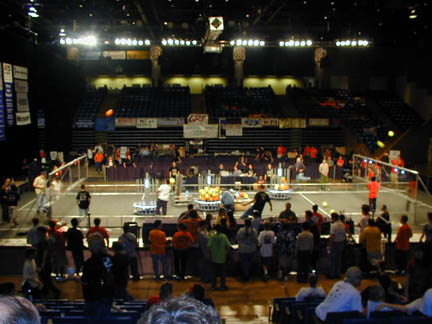 |
Led by dedicated Castlemont teachers Erin Carlson, Kenneth Mason, and David Upchurch, the "Hybrids" recently completed construction of their third robot and entered the 11th Annual US FIRST (For Inspiration and Recognition of Science and Technology) Robotics Competition, a nationwide event that teams professionals and young people together in order to solve an engineering design problem. Founded by inventor Dean Kamen, the program reaches more than 20,000 students representing over 650 teams in 17 regional competitions. Students participating this year were eligible for $1.7 million in scholarships.
The team had six weeks to meet their "Zone Zeal" engineering challenge for 2002: to design a robot that would race around a playing field gathering balls, put the balls into goals and place the goals in their scoring zone--all in less than two minutes. They received three boxes of parts and software-- wheels, several types of motors, wire, hydraulic cylinders, and a programmable control module--that they needed to convert into a 130-pound robot that performs complex tasks in competition with other robots.
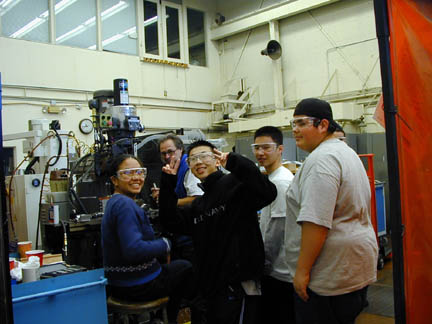 |
|
Mario Cepeda of Engineering’s Technical Integration Group working with Hybrid team members in their Robotics workshop at Castlemont High School in Oakland (above). Their competition robot (below) had deployable arms that lowered on both sides to double their grabbing capacity. Photo by Paul Harris |
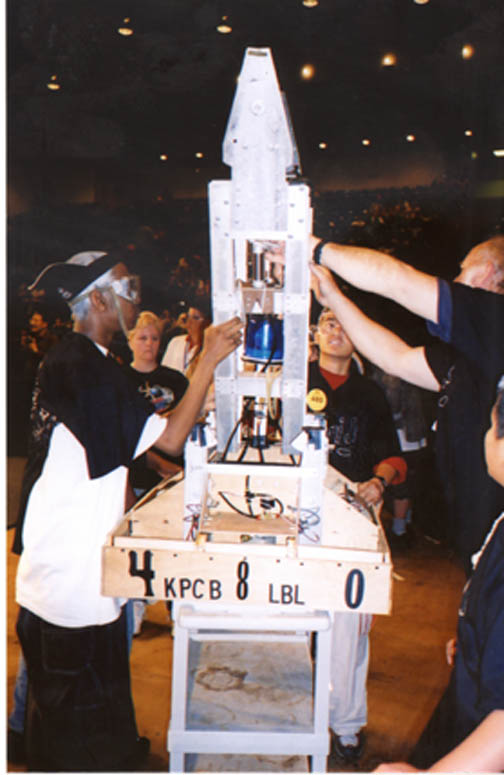 |
Hybrid team members from the Engineering Division--Brian Butler, Mario Cepeda, Luis Curtis, Bart Davis, Keith Franck, Paul Harris, Erick Herrarte, Deb Hopkins, Clifton Jones, Murat Karaca, Tom Miller, and Jim O’Neill -- traveled to Castlemont in Oakland on Tuesdays and Saturdays for the team’s working sessions, and several of the student Hybrids visited the Technical Integration Group (TIG) in Building 25 to design and build the robot’s drive train.
"Our role was to support the kids without interfering," said Deb Hopkins. "They’ll learn more from their failures than their successes, and the pride of accomplishment should be theirs alone."
"When the boxes of parts came, it seemed like it would be really difficult," said Jesus De Haro, a sophomore who joined the team at the recommendation of his autoshop teacher. "There were all these things I’d never even heard of. But it turned out that I was good at building stuff. We had to figure out how to make it all work, and it was difficult, but in the end we got it done. Now I’m hooked."
With the exception of wheel bushings and motor mounts machined by TIG, the Hybrids constructed their robot out of wood and sheet metal using hand tools, setting their robot apart.
"I’ve certainly seen the impact of this program on the students," says Castlemont’s David Upchurch. "It frees their minds while at the same time grinding in the physics that we teach in class. Showing a real world application enhances our ability to teach in the classroom."
The three-day regional competition at San Jose State University found hundreds of students debating game strategies and sharing tools amid an intense rush of testing and last-minute modifications.
"I was so happy and proud to be the only Oakland school involved in the competition," said Yentl Rice, a sophomore on the team who is unsure whether or not she wants to be an OB/GYN or an engineer in the future. "It was great to be there competing in spite of our reputation."
Because it was necessary for the robots to race around a playing field and gather soccer balls in large wheeled baskets, the Hybrid robot’s unique double-arm design allowed the robot to grab and control two baskets simultaneously. The robot performed as designed, successfully maneuvering the field with baskets in tow for all eight rounds. The Hybrids did not place high enough in the competition to advance to the championship event in April at Walt Disney World’s Epcot Center in Orlando; however, they did take a trip to Disneyland, accompanied by Erick Herrarte and Deb Hopkins.
The current collaboration with the Hybrid team is just the first of many steps in building a long-term, year-round effort to work with teachers to fund and develop a robotics curriculum. Future efforts will include tutoring and fund raising. For example, the entry fee for the competition is several thousand dollars in addition to funds for small parts, team t-shirts, and travel. Commitment and resources are required to ensure continuity and develop a program that supports as many students and teachers as possible.
"I think the students are more interested in post-high school plans since participating on the Robotics team," said Erin Carlson. "Working with the Lab showed the students that there are many other ways to go, more options available to them than they were aware of before."
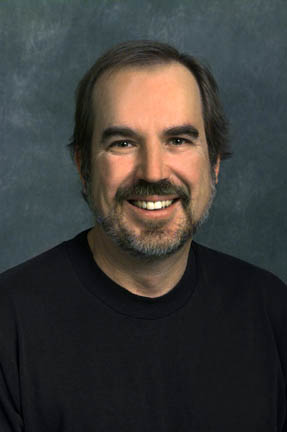 |
Harry Scheid, an electronic engineering associate for the Engineering Division working at the ALS, died on Friday, May 17, as the result of a ruptured aneurysm in his brain. He was 49.
Scheid was born June 13, 1952 in Burton Wood, England. Like his father, Harry was a military man and served in the Air Force from 1973 through 1976. He remained in the Reserves until his death.
Scheid worked at the Lab for 15 years. He was active with Little League Baseball, the Boys Scouts of America, and served as the Vice President of UPTE Local 184 for the last several years. He is survived by his wife, Linda Bernard-Scheid.
A memorial service was held at the Fairfield Funeral Home on May 22. For those who wish to make a donation on Harry’s behalf, please contact the Air Force Memorial Foundation, P.O. Box 97026, Washington, DC 97026.
A project that has been only a dream for years -- the deconstruction of the decommissioned Bevatron building and accelerator -- will show signs of life this spring and summer with the exodus of hundreds of truckloads of waste materials off-site.
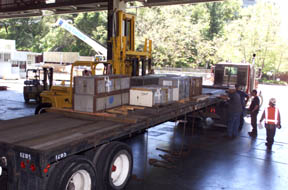 |
A massive undertaking that has been estimated to cost $70 million before it’s all over, the removal of the Bevatron is considered critical to Berkeley Lab’s plans for future development. At more than 164,000 gross square feet, the building occupies about 10 percent of the buildable land on the hill. Most of it is now unused, underutilized or non-code-compliant.
Under the leadership of project manager Margaret Goglia, the salvage and disposal process took shape with initial truck hauling last week. It was enabled by $2.5 million in funding from the Department of Energy’s Excess Facilities program and another $1.5 million in Berkeley Lab funds for this fiscal year.
Up to eight trucks per day will depart the lab through the Blackberry Gate, laden with tons of abandoned motor generators and parts, magnets, concrete shielding blocks and beam line components. Uncontaminated pieces will go to the landfill in Richmond if recycling options prove impossible. Those with detectable radiation will end up buried at the Nevada Test Site.
It’s not much, but it’s a start. Goglia estimates that it will take about $10 million a year for six or seven years to level the site and make it habitable. The DOE’s newest science director, Ray Orbach, will be given a first-hand look at the project during the Office of Science on-site review on June 18.
The Bevatron compiled a storied legacy during the almost 40 years it was active, much of it as the world’s most powerful particle accelerator. Since its commissioning almost 40 years ago, the venerable synchrotron made major contributions to four distinct areas of research: high-energy particle physics, nuclear heavy-ion physics, medical research and therapy, and studies of radiation damage and heavy particles in space.
The Bevatron played the leading role in three of the most important discoveries of particle physics: experimental studies of "strange" particles leading to the discovery of parity non-conservation (the first known example of a lack of symmetry in nature); the discovery of nuclear antimatter (the antiproton and the antineutron); and the discovery of "resonances" -- the particle explosion of the 1960’s that led to the development of the quark model and the current understanding of the basic nature of matter.
The beam was turned off for the last time on Feb. 21, 1993.
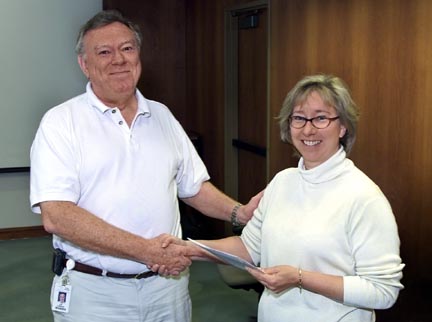 |
Operations Deputy Director Sally Benson stole a moment from her weekly executive meeting to honor Facilities manager Bob Camper with a service pin, recognizing 10 years of outstanding service to the laboratory and the University of California. Camper will follow this milestone with one of his own -- he’ll retire before the end of the year.
Friends of Science Continues
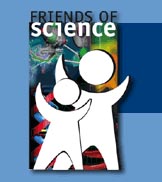 |
Friends of Science, a community outreach program to promote public understanding of the Lab’s research, will continue on June 3. Eva Nogales of the Lab’s Physical Biosciences Division and the UCB Department of Molecular and Cell Biology will give a presentation on the architecture of large biological complexes, such as the atomic model of tubulin. Tubulin is the protein that is the foundation of a living cell’s cytoskeleton and is the key treatment of some types of cancer.
Entitled "Portrait of a Protein That Can Change the Fate of Cancer," Nogales will discuss the 20 year search to find the molecular structure of tubulin that ended with her lab’s successfully creating the first 3-D molecular model of tubulin in 1998.
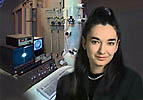 |
"If you know what a protein looks like at the atomic level, you can study and possibly learn to manipulate certain aspects of molecular behavior," said Nogales. Her lab has most recently made news by producing the first 3-D images of the protein complex that initiates DNA transcription.
Nogales’s presentation will be held from 6:00 to 7:30 p.m. in the Lab’s Perseverance Hall.
To learn more about the Friends of Science program, visit our website at http://www.lbl.gov/friendsofscience
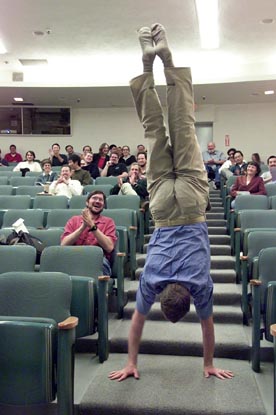 |
| Photo by Roy Kaltschmidt. |
Kicking Up His Heels After 30 Years
NERSC Webmaster Jed Donnelley recently accepted his 30-year service award in a unique fashion, making good on a challenge he set for himself early in his UC career. In addition to his official Web duties, Jed is also NERSC's unofficial juggler, unicyclist and guy-who-walks-on-his-hands. At Lawrence Livermore, where he started his career, Jed would keep in shape by walking down a flight of stairs, then taking the elevator back up, all the while walking on his hands. It was during one of these jaunts that he decided he'd like to approach the stage on his hands when he earned his 30-year pin. For the record, he did give the Bldg. 50 auditorium steps a test run before attempting his 25-foot hand walk.
News from the Travel Office
YCAL Discount Airfares
The current YCAL fares for reduced fare travel will expire Sunday, June 30, although written confirmation that the rates will be extended for another year is expected to arrive soon. Until that confirmation is received, Maritz and Travel Power cannot price itineraries for travel beyond June 30 at YCAL rates. You may still make reservations and budget airfare using this year’s YCAL rates and have the ticket issued once the new rates are in place. The fares are expected to remain the same.
Corporate Credit Cards
Lab employees who travel even once a year are eligible to receive a Lab sponsored corporate card for business expenses with their supervisor’s approval. The cardholder is responsible for paying all outstanding balances each month. Although no credit check is performed upon application, card privileges are suspended if no payment is received in 60 days, terminated if no payment is received in 90 days and reported to credit bureaus if no payment is received in 150 days. Additional information about the corporate card program may be found on the Travel web site at http://travel.lbl.gov/.
Itinerary/Receipts
Maritz is moving toward elimination of paper receipts for electronic tickets. Travelers will receive an email with an electronic version of each trip invoice, which is an acceptable document to enter into the secured area of domestic airports and can also be used for expense reporting. You may also obtain copies of your itinerary from VirtuallyThere.com. A non-Maritz commercial web site, VirtuallyThere allows you to retrieve invoices up to 70 days past date of issue.
Lab to Participate in City-Wide Emergency Response Drill
Berkeley Lab will be a participant in a five-agency emergency response exercise on Thursday, June 6, that will simulate a terrorism incident in the East Bay. The Lab’s Emergency Operations Center (EOC) at the fire house will be activated for the drill from 9 to 11 a.m.
Participating agencies include the City of Berkeley, Alta Bates Summit Medical Center, Bayer Corporation, the University of California at Berkeley, and Berkeley Lab.
These five agencies will simultaneously follow a crisis scenario generated from the State Emergency Preparedness Office in Oakland. This exercise provides an opportunity for these major organizations in our community to practice a unified response. No actual activity will take place in the city, but a news videotape has been prepared to describe the drama as it unfolds.
In the past, earthquake and large-scale fire scenarios were the basis for emergency preparedness exercises. The June 6 terrorism-oriented session is designed to build on this existing knowledge base by improving the ability of the community as a whole to respond effectively to a broader range of potential emergency situations.
On-site emergency procedures and interagency cooperation will be tested for effectiveness with a final debriefing at UC Berkeley to review the lessons learned.
Courier Services
The Facilities Department provides rush courier service with pick-up and delivery both on- and off-site. Transportation can deliver up to 2,000 pounds in the Bay Area or in central or northern California. Onsite materials will be delivered within one hour. For pick-up call X5404.
Courier service (two-hour, four-hour, same day, and rush) is also available from IDS Courier, which operates 24 hours a day and provides pick-up and delivery anywhere in the Bay Area and in parts of northern and central California. For information call 548-3263.
Lab Classic Car Event
Auto enthusiasts interested in participating in an on-site classic car and hot rod car show on Friday, June 21, should contact Kevin Bradley at X4319 or kmbradley@lbl.gov for information and entry forms. All classic, hot rod, vintage and special interest vehicles up to 1973 are welcome. This event is sponsored by the Employee Activity Association (EAA).
Oakland A’s Discount Tickets on Sale
The Employee Activities Association is sponsoring a baseball day with the Oakland A’s vs. the Texas Rangers on Sunday, July 21 at 1:05 p.m. The cost for Lab employees is $7 per ticket discounted from $16. Tickets will be on sale every Wednesday from Noon to 1 p.m. in the cafeteria lobby on a first come, first served basis. For more information contact Lisa Cordova at X5521.
Yoga Club
The Berkeley lab Yoga Club now offers classes three times a week: Wednesday, Thursday and Friday at 12:00 in Bldg.70A Rm. 3377. All levels are welcome. Please wear loose clothing. Mats and props are provided. Classes are $10 for drop-in and $8 if a series of 4 classes are purchased.
Infant/Child CPR Classes
The LBL Fire Department will be offering a series of Infant/Child CPR classes between now and the end of the year. Classes are free and open to family members. A current Adult CPR certificate, from the Lab or any other training program, is required. This class is scheduled for 6-8 p.m. on Tuesday, June 18, Wednesday, September 25 and Wednesday, December 4. Preregistration is required. For more information, call the EHS training program at X2228, or visit their web site at http://www.lbl.gov/ehs/html/training.htm.
Alexander von Humboldt Association to Meet
"The Future of our Planet," a topical session of the 4th Annual Meeting of the Alexander von Humboldt Association of America, will be held Saturday, June 1 on campus at Wheeler Hall. Speakers include John Schellnhuber, Director, Potsdam Institute for Climate Impact Research (PIK); F. Sherwood Rowland, 1995 Nobel Laureate, Chemistry University of California, Irvine; and Peggy Kuo, lawyer, International War Crimes Tribunal, The Hague. For more information, visit http://www.avhaa.org/
FRIENDS OF SCIENCE EVENT
"Portrait of a Protein That Can Change the Fate of Cancer."
Eva Nogales,
Life Sciences Division
6 p.m. Perseverance Hal
KARATS,"THE GOLD PEOPLE"
8:00 a.m. - 3:00 p.m. Cafeteria Lobby
LBNL MACINTOSH USERS GROUP JUNE MEETING
"Veritas NetBackup System"
11:00 a.m., Bldg 90-3148
Send us your announcements
Announcements for the General Calendar and Bulletin Board page may be sent to MSFriedlander@lbl.gov. Seminar & Lectures items may be mailed to currents_calendar@lbl.gov. You may also fax items to X6641 or mail them to Bldg. 65B. The deadline for the May. 31 issue is 5 p.m. Monday, May 27.
LIFE SCIENCES DIVISION SEMINAR
Imaging the Pathobiology of Traumatic Brain Injury
Speaker: David Hovda, UCLA
4:10 p.m., Bldg 66 auditorium
BERKELEY SPECTROSCOPY CLUB SEMINAR
Terahertz Pulses Unleashed: Far-IR Spectroscopy and Ultrafast Dynamics
in Solids
Speaker: Robert Kaindl, Materials Science Division
10:00 a.m., Bldg 6, rm 2202
LIFE SCIENCES DIVISION SEMINAR
Malaria Genetics
Speaker: Joseph Derisi, UCSF
4:10 p.m., Bldg 66 auditorium
NUCLEAR SCIENCE DIVISION COLLOQUIA
The Endless Universe
Speaker: Paul J. Steinhardt, Princeton University
11 a.m., Bldg 50 auditorium
|
Date |
Course |
Time |
Building |
|
|
6/4 |
EHS 52 |
Back Safety |
10:00 - 12:00 |
51-201 |
|
6/4 |
EHS 800 |
Occurrence Reporting Training |
9:00 - 11:00 |
48-109 |
|
6/4 |
EHS 256 |
Lockout/Tagout |
1:30 - 3:00 |
51-201 |
|
6/5 |
EHS 116 |
First Aid |
8:30 - 12:00 |
48-109 |
|
6/6 |
EHS 60 |
Ergonomics for Computer Users |
10:30 - 12:00 |
51-201 |
|
6/10 |
EHS 260 |
Basic Electrical Hazard Awareness |
1:00 - 2:30 |
51-201 |
|
6/11 |
EHS 10 |
Introduction to ES&H at LBNL |
8:00 - 10:15 |
50-Aud |
|
6/11 |
EHS 348 |
Chemical Hygiene Safety |
9:00 - 12:00 |
51-201 |
|
6/11 |
EHS 231 |
Compressed Gas Safety |
1:00 - 3:30 |
51-201 |
|
6/12 |
EHS 123 |
Adult CPR |
8:30 - 12:00 |
48-109 |
|
6/12 |
EHS 256 |
Lockout/Tagout |
1:00 - 2:30 |
51-201 |
|
6/13 |
EHS 400 |
Radiation Protection-Fund. |
9:00 - 12:00 |
51-201 |
|
6/13 |
EHS 280 |
Laser Safety |
1:00 - 4:00 |
51-201 |
|
6/13 |
EHS 135 |
Earthquake Safety |
2:00 - 3:00 |
48-109 |
|
6/14 |
EHS 432 |
Radiation Protection-Lab Safety |
8:00 - 12:30 |
51-201 |
|
6/18 |
EHS 20 |
ES&H for Supervisors |
9:30 - 11:30 |
51-201 |
|
6/18 |
EHS 735/ |
Biosafety/Bloodborne Pathogen |
1:30 - 2:45 |
51-201 |
|
6/18 |
EHS 125 |
Infant/Child CPR |
6:00 - 8:00 |
48-109 |
|
6/19 |
EHS 275 |
Confined Space Hazards |
8:30 - 11:00 |
51-201 |
|
6/19 |
EHS 530 |
Fire Extinguisher |
10:00 - 11:30 |
48-109 |
|
6/19 |
EHS 274 |
Confined Space-Retraining |
11:00 - 12:00 |
51-201 |
|
6/19 |
EHS 330 |
Lead Hazards Awareness |
1:00 - 2:00 |
51-201 |
|
6/20 |
EHS 60 |
Ergonomics for Computer Users |
10:30 - 12:00 |
51-201 |
|
6/20 |
EHS 10 |
Introduction to ES&H at LBNL |
1:00 - 3:00 |
51-201 |
|
6/25 |
EHS 604 |
Hazardous Waste Generator |
9:30 - 11:00 |
51-201 |
|
6/25 |
EHS 622 |
Radioactive & Mixed Waste |
11:00 - 12:00 |
51-201 |
|
6/26 |
EHS 210 |
Hoist Safety |
10:30 - 12:00 |
51-201 |
|
6/26 |
EHS 260 |
Basic Electric Hazard Awareness |
1:30 - 3:00 |
51-201 |
To enroll, contact Valarie Espinoza at VMEspinoza@lbl.gov or enroll via the web at https://hris.lbl.gov/self_service/training/. Preregistration is required for all courses except EHS 10. For a full, updated schedule, see http://www-ia1.lbl.gov/schedule/.
‘98 TOYOTA CAMRY CE sedan 4 dr, 4-cyl, 2.2 L, a/t, front wd, beige, exc cond, 23.5K mi, $12,000/bo, Kathy, X6594, 530-1210
‘96 NISSAN SENTRA GXE, 5 spd, teal, 4 dr, 63K mi, am/fm/cass, dual airbags, ac, pwr win/locks, 1 owner, very good cond, well maint & recently serviced, 40 mpg hwy, $5,900, Dave, X4024
‘93 XLT DODGE CARAVAN V6, 3.3 L, 140K mi, ac needs new compressor, otherwise in really good shape, seats 7, int well kept, $4,000, Cherie, X7898, 612-4832
‘87 MAZDA 323 DX hatch, silver, 2 dr, 5-spd, 197K mi, am/fm/cass, 1 owner, just smogged, 34 mpg, huge cargo cap, $975, Dan, X6734, (925) 946-1467
ALBANY, perf for sabbatical, lge, elegant & comfortable furn 2 bdrm 2ba condo, avail by week or month, Geoffrey, 848-1830, gfchew@mindspring.com
BERKELEY sublet 8/1-8/31, level-in, sophisticated home, ideal for couple, close to the Claremont, UC, shops, eat-in kitchen, w&d, 2 gardens, 2 full ba, 1 1/2 bdrm, lge liv rm & formal din rm, rent incl weekly housekeeper, util & gardener, ronna@mindfulmanagement.com, 848-6812
BERKELEY, lge sunny rm w/ window seats & flower box in a sunny 2-person, 3 bdrm house, avail at the end of May, move-in date neg, hardwood floors, back yard, great smelling jasmine everywhere, compost, bike shed, w&d, clothesline, near Milvia and Parker between the 2 farmers’ mrkts, near shops, $780/mo + util, street parking, sublet thru end of Aug or long term OK, Elisa, X7863, 665-9091
BERKELEY, lower Hearst Ave, sm studio townhouses w/ decks, parking incl, village setting, academic environment, $925 - $975, lizhappy@jps.net, 666-1150
KENSINGTON, furn rms for rent during summer for visiting faculty or staff, couple okay, kitchen & laundry facilities, $400/mo for single; $700/mo for couple, Ruth, 526 2007
NORTH BERKELEY b&b for visiting scholars, $650/2 wks, $850/mo, avail for 2 wks to 8 mos, 1 person per rm, 2 rms in house, 1 garden cottage, breakfast every day & bike avail, close to pub trans, avail now, Helen, 527-3252
NORTH BERKELEY HILLS, student or scholar for rental & p/t companion to Owen Chamberlain 3 hrs on 3 late afternoons with pay, furn rm w/ ba, pvt entrance, access to kitch, w&d, sunny garden porch, easy bus/bike to Lab, no smoking, congenial household, $450 w/ util, Senta, 524-4654
NORTH BERKELEY, perf for sabbatical, furn lge sunny 1 bdrm apt, walk to campus & shuttle, many amenities, all comfort, pvt garden, gated carport, avail after 7/1, (REPEAT)
NORTH OAKLAND furn 1200 sq ft 2 bdrm upper flat in duplex w/ yard, walk to Rockridge/Piedmont shops & shuttle, 7/02-8/02, $1,000/mo, Tom, TPWenzel@lbl.gov, X5753, 601-0574
NORTH OAKLAND, rm avail 6/01 in spacious, sunny 2 bdrm w/ garden, hardwood floors, well equipped, walking distance to Rockridge shuttle, $750/mo, Kathy, 595-9585
RICHMOND 3 bdrm 1 ba, Atchison Village Mutual Homes, half of duplex w/ fenced yard, near Pt Richmond, freeway, sell for $105K, Rolf, X5068, rjmehlhorn@lbl.gov
SAN PABLO 4 bdrm 2 ba 2-story home for June, jacuzzi, deck, patio, sun rm, yard, w&d, pet friendly, garbage pd, $2,900, Rafael@goink.com, (415) 235-4794
WALNUT CREEK, 1601 Alvarado Ave, lge 1 bdrm apt on ground floor of 4plex, patio, carport, pool, AEK, avail after 5/15, $850/mo, Bob, (925) 376-2211
LAB STAFF EMPLOYEE seeks short-term sublet or rental in Berkeley area, Jul - Aug -- Sep or 1 yr+ house rental, Peter, X5321
MARRIED PhDS, seek a rm w/ a small kitchen to rent, very nice & quiet, for use during the wk instead of commuting, Jody, X7004, JRSchwartz@lbl.gov
AIWA 2-tape deck with radio, needs speakers; Samsonite grey hard shell luggage, $20; soft-sided black/leather luggage 2 pieces, $15; 3-step yellow retro step stool, $10; Victorian-style white wicker plant stand, $25, Susan, X5437
COMP ARMOIRE: pine, 2 drs w/ fold-down desk & room for printer, great cond, Zalaysha, X7692
GAS DRYER, good cond, $100, Fafy,526-5495
MOVING SALE: GE washer, great shape, 5 yrs old, $200/bo; swivel bent cane chairs, $30/pr; futon frame & matt, full, $25/bo; metal work table, $10; Solid oak door, smooth, unfinished, used as desk top, b/o, decorative cement blocks, b/o, Camilla, X6998, (415) 824-7909
MOVING SALE: refrigerator, 20cf, side-by-side, almond, exc, $100; ext 32’ aluminum ladder, $100; violin, full size, $100; 2 deck chaise lounges w/ cushions & wheels, deck table, deck umbrella w/ mount, $80; queen bed, complete set w/ frame, matt & box, $80; twin bed, complete set w/ frame, matt & box, $40; queen headboard w/ storage, $10; range hood, 32', like new, $10; 3-man vinyl boat w/ oars & pump, never used, $15; 2-person tent, $5; storage cabinet w/ 2 drs, 6’x2’, $20; metal frame for queen bed, $5; desk lamp, $5; photos avail, Ming, X5616, 530-0462
PARKING: Off-street parking avail between now & Aug in Berkeley's Elmwood District, $20/wk or $50/mo, Susan, X5437
ROUND BUTCHER BLOCK table, extraordinarily thick, pedestal base, 54" diameter, 2" thick., handsome, recently refinished, 5 matching bentwood chairs, $300 for table, $50/ea for chairs, Art, X1060
SANYO SPRINT-PCS system cell phone, used, charger incl, $25/bo, Liz, X6179
SF OPERA TICKETS, balc pr, 2nd row ctr, Giulio Cesare 6/29, $120/pr, Paul, X5508
SUNTRIPS TRAVEL VOUCHERS good thru 8/02, face value $50, 5 @ $30/ea or all for $125, Richard, X6320, 845-1723
WATER SKIS, 68", Taperflex wide tunnel & Lake Reoion fan tail, $25/ea, photos avail, Ming, X5616, 530-0462
MAPLE V version 4 for Windows wanted, Joern, X 2407
LAWNMOWER, electric or gas, Fafy, 526-5495
KIHEI, MAUI, 1 bdrm condo, across the street from Kam 2 beach (best beach on Maui), fully equipped, view the ocean & Haleakela, $400 + 12% Hawaii hotel tax ($450/wk), Fred or Shar 981-2073 days, 523-4150 eves
LAKE TAHOE Hyatt Regency, deluxe rm, 5 nights for 2 people, avail thru 6/6, was $690, make b/o, Barbara, 652-7044 eves
PARIS, FRANCE, near Eiffel Tower, furn elegant sunny 2bdrm/1ba apt, avail for sabatical and/or vacation, all year round by wk/mo, Geoffrey, 848-1830
SANTORINI, GREECE, package for 2, jr suite, 5 nights, breakfast & dinner incl, gorgeous hotel, avail through 10/30, $790/bo, Barbara, 652-7044 eves
TAHOE KEYS at S. Lake Tahoe, 3 bdrm house, 2-1/2 bth, fenced yard, quiet, sunny, close to attractions, great view of water & mtns, $195/night, 2 night min, Bob, (925)376-2211
Ads are accepted only from LBNL employees, retirees, and onsite DOE personnel. Only items of your own personal property may be offered for sale.
Submissions must include name, affiliation, extension, and home phone. Ads must be submitted in writing via e-mail (fleamarket@lbl.gov) or fax (X6641). Ads run one time only unless resubmitted, and are repeated only as space permits. They may not be retracted.
The deadline for the June 14, 2002 issue is Thursday, June 6.